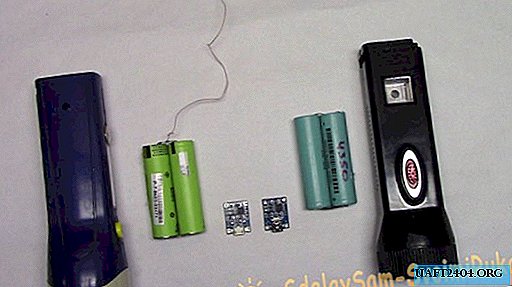Share
Pin
Tweet
Send
Share
Send
I decided to modify the old flashlights with a lead-acid battery on Li-ion.
Batteries picked up a popular size 18650 seized from an old laptop battery.
For revision we need:
- - lanterns;
- - batteries 18650;
- - charge controllers;
- - BMS boards;
- - wires;
- - hot glue, soldering iron, tools.
We disassemble the flashlights and take out the filling (old battery, charger). I had them on the LEDs, although they are still selling on the incandescent lamp.
My size of flashlights turned out to be just a pair of 18650. We solder in pairs, I had pairs welded initially. It is impossible to solder lithium batteries, so when disassembling, try to leave part of the tape, you can then solder it. Previously, I measured the capacity and it will be enough for hours of work.

I removed the BMS boards from the old batteries from mobile phones. These boards will protect against low battery levels. We solder the output wires and put it aside.

I mounted the charge controller boards in plastic inserts. Later I will install them in the place where there was a retractable power plug. I made holes in the plastic blanks and the connectors on the boards entered them as if they were my native place, I didn’t even stick them. The boards are taken with different connectors, which were available.

Now we take BMS boards and solder them to our 18650 batteries. Although the elements on the boards are slightly heated, I laid a layer of electrical tape, just in case.

Solder the charge controller board. Install the batteries in the housing. As a spacer, I applied a piece of wine cork. For reliability, the board glued with hot glue.

Now we solder the output wires from the batteries (from the BMS board) to the buttons. I also thought about removing a single LED on a black flashlight, but still decided to leave it. There is a place for alone and a switch allows it to be switched on separately.

Pre-collect flashlights
The boards on the reflector with LEDs were of different connections. On the blue flashlight, the LEDs are connected in parallel, the current-limiting resistor is one. This connection is wrong, but I decided to leave it because I did not have so many resistors. On the black flashlight, for each LED, a current-limiting resistor is connected, all these assemblies are connected in parallel. This connection is correct.

We collect a flashlight
To the place where there was an engine pushing the network plug, I cut out the plexiglass insets and wiped them with sandpaper to give them a matte finish. I pasted the inserts on superglue, you need to glue to one half, suddenly you need to disassemble the flashlight.

The charge process is very clearly visible through the insert window. Red color indicates a charge, when blue lights up - the charge is over.

That's just how you can modify almost any flashlight. I finalized a large number of flashlights using this technique. They have been working for more than one year, and why they should not work.
Watch the flashlight conversion video
Share
Pin
Tweet
Send
Share
Send











